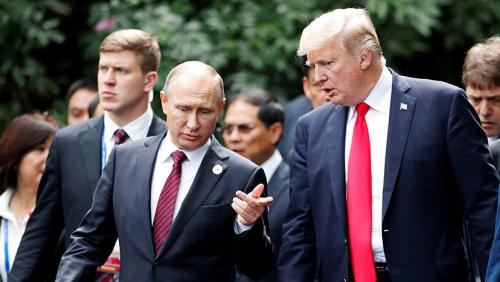The meeting of Trump and Putin in Helsinki
The strategic objective of Trump is to weaken big financial capital and strengthen the productive (industrial) capital of the United States.
- Opinión

President Trump has created a storm in the US establishment with ramifications in all the financial centers of the world. Since the announcement of his candidature in 2015, he has become a headache (bête noir) for the segment of the dominant class that promotes “globalization” as the strategy to consolidate its power on a world scale. The recent summit in Helsinki between Trump and Vladimir Putin of Russia unleashed a hysteria rarely seen before in the power circles of the United States.
Before analyzing the meeting with Putin, one should recall that Trump disregarded the trade agreements with his allies, introduced a policy of “zero tolerance” on the Mexican border and declared a trade war with China and Western Europe. The US establishment responded unrelentingly with all the elements within its reach. Nonetheless, in the United States, Trump continues to receive support from what he calls his “social base” and from the nationalist right in the rest of the world.
What the mainstream press calls Trump’s errors (to employ a very soft term) in reality follow a clear objective. One that is also very dangerous for the interests of economic power concentrated in the financial centers (above all in the banks of New York). The strategic objective of Trump is to weaken big financial capital and strengthen the productive (industrial) capital of the United States. To achieve this goal, Trump needs to continue in power until 2024 (two presidential terms). The first step is to win the partial elections (Congress and the Senate) in November 2018. If he does not win those, it is improbable that he could be re-elected in 2020.
The slogan “America First” synthesizes the Trump policy. On the world scene, he needs to undermine globalizing policies in order to return to a competitive world economy. His point of departure has as its base the supposition that the United States can win over the other countries of the world and subject them to a global “pax Americana”. The globalizing thesis, promoted as from the 1970s by all the presidents of the United States, was based on opening up borders and building a world super-government led by technocrats, and dissolving national identities. The capital of the finance center of the United States would continue to lead, in alliance with Western Europe and the new emerging power of China.
The big capitalists behind Trump want to undo the globalizing scheme. They seek to minimize trade agreements, destabilize the European Union and slow the growth of the People’s Republic of China. The White House has become a laboratory where the most incredible theses are shuffled. They are all directed to one goal: putting an end to the power of the establishment. In the United States, Trump can count on the enthusiastic support of a mass of impoverished workers, small entrepreneurs and big industry on the edge of bankruptcy. Another sector of the US population has moved to the left, following the discourse of Bernie Sanders. The establishment, in spite of its enormous economic and press power (CNN, NBC, NYT, Hollywood) is at bay and feels harassed. Trump and his team know this and continue to provoke.
Helsinki was the most recent incident and will probably not be the last. In the “great plan” elaborated some twenty-five years ago by political scientist Brzesinsky, Russia was the weak link in the system. According to this thesis, Russia is a poor country in capitalist terms but very strong militarily. It had to disappear. Meanwhile, China had to become the partner of the United States in a globalized world. When Trump goes to Helsinki, he rejects the proposals of Brzesinsky and offers Putin an alliance and the stability that he badly needs. In exchange, Moscow becomes a minor ally, similar to Japan and Germany in the great geopolitical map.
In this Trumpian strategy, China and the marginalized world (“third world”, “underdeveloped” or “poor” countries) are excluded. Russia is the key to enclose China from the North and the West. The United States will be in charge of containing the dragon along its East coast. The rest of the world will be governed, according to this strategy, by servile agents and, when necessary, by “humanitarian” military interventions.
The establishment knows that this face-off is a matter of life or death. They see Trump as a traitor to the globalizing capitalist cause and want his overthrow. If he loses the mid-term elections in November, financial capital will organize a trial to separate him from office before 2020.
In summary, Trump aspires to build a system that maintains a global geopolitical equilibrium with its center in the United States. To achieve this, he has to destabilize Western Europe (Germany), contain China, underpin a weak Russia and keep the rest of the world in neo-colonial chaos.
July 26 2018.
(Translated for ALAI by Jordan Bishop)
Marco A. Gandásegui, Jr. is professor of Sociology at the University of Panama and Associate Researcher with CELA.
Del mismo autor
- La pandemia no es el fin del capitalismo 23/04/2020
- Hay que masificar las pruebas contra un virus clasista 19/04/2020
- ¡Qué falta hacen los Comités de Salud de J. Renán Esquivel! 09/04/2020
- La desigualdad social y la desconfianza contribuyen a la epidemia 02/04/2020
- Hacen falta más ‘pruebas’ para ‘suprimir’ el coronavirus 26/03/2020
- La crisis del capitalismo y el coronavirus 19/03/2020
- Urge una movilización general para atacar el corona-virus 12/03/2020
- Se necesita liderazgo y transparencia para enfrentar el corona-virus 05/03/2020
- EEUU veta relaciones entre Panamá y China 27/02/2020
- Roberto Arosemena, sus ideas perduran y sus luchas continúan 20/02/2020








